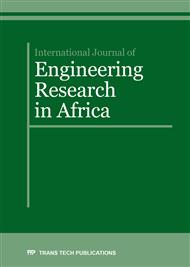[1]
Reda-Taha, M. M., A. S. El-Dieb, M. A. Abd El-Wahab; and M. E. Abdel-Hameed, (2008), Mechanical, Fracture, and Microstructural Investigations of Rubber Concrete, Journal of Materials in Civil Engineering, Vol. 20, No. 10, October 1, (2008).
DOI: 10.1061/(asce)0899-1561(2008)20:10(640)
Google Scholar
[2]
Gu, R.R. (2005) Beneficial Reuses of Scrap Tires in Hydraulic Engineering, in Handbook of Environmental Chemistry, Vol. 5, Part F., Vol. 1, pp.183-215.
DOI: 10.1007/b11436
Google Scholar
[3]
Fattuhi, N. I., and Clarck, L. A. (1996). Cement-Based Materials Containing Shredded Scrap Truck Tire Rubber., Construction Building Material, Vol. 10, No. 4, p.229–236.
DOI: 10.1016/0950-0618(96)00004-9
Google Scholar
[4]
Huang, B., Li, G., Pang, S., and Eggers, J. (2004) Investigation into Waste Tire Rubber-Filled Concrete, Journal of Materials in Civil Engineering, Vol. 16, No. 3, pp.187-194.
DOI: 10.1061/(asce)0899-1561(2004)16:3(187)
Google Scholar
[5]
Yang, S. P., Kjartanson, B. H., and Lohnes, R. A. (2001) 'Structural Performance of Scrap Tire Culverts. ', Canadian Journal of Civil Engineering, Vol. 28, No. 2, p.179–189.
DOI: 10.1139/l00-082
Google Scholar
[6]
Kassim, T., B. Simoneit, · K. J. Williamson, (2005) Recycling Solid Wastes as Road Construction Materials: An Environmentally Sustainable Approach, in Handbook of Environmental Chemistry, Vol. 5, Part F., Vol. 1, pp.59-181.
DOI: 10.1007/b98264
Google Scholar
[7]
Cecich, V., Gonzales, L., Hoisaeter, A., Williams, J. and Reddy, K. (1996) Use Of Shredded Tires As Lightweight Backfill Material For Retaining Structures, Waste Management and Research (1996) Vol. 14, p.433–451.
DOI: 10.1177/0734242x9601400503
Google Scholar
[8]
El-Gammal, A., A. K. Abdel-Gawad, Y. El-Sherbini, and A. Shalaby, (2010) Compressive Strength of Concrete Utilizing Waste Tire Rubber, Journal of Emerging Trends in Engineering and Applied Sciences, Vol. 1 No. 1 , pp.96-99.
Google Scholar
[9]
Humphery, D.N. (2000), Tire Shred Save Money for Maine, TR News. Issue. 206, pp.42-44.
Google Scholar
[10]
Vent-Axia, Wind Pressure and Flow Around Buildings., Vent-Axia - Heating, Ventilation, and Air Conditioning. Unknown. 03 May (2006).
Google Scholar
[11]
Freilich, B. J., and J. G. Zornberg. (2010) A Model for the Characterization of the Scrap Tire Bale Interface., Proceedings of GeoFlorida 2010: Advances in Analysis, Modeling & Design pp.2933-2942.
DOI: 10.1061/41095(365)299
Google Scholar
[12]
Hammer, C. (2004) Designing Building Products Made With Recycled Tires Report to the US State of California Integrated Waste Management Board, www. ciwmb. ac. gov/Publications/ Accessed September 5th (2016).
Google Scholar
[13]
Meyer, C. (2009), The Greening of the Concrete Industry, Cement and Concrete Composites, Vol. 31, pp.601-605.
DOI: 10.1016/j.cemconcomp.2008.12.010
Google Scholar
[14]
LaRocque, C.J. (2005). Mechanical Properties of Tire Bales, Masters Thesis, Department of Civil, Architectural and Environmental Engineering, The University of Texas at Austin.
Google Scholar
[15]
Humphrey, D. N. and Katz, L. E. (2001).
Google Scholar


